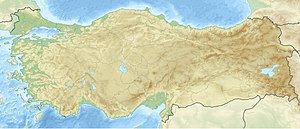Çayönü Tepesi is a Neolithic settlement in southeastern Turkey which prospered from circa 8,630 to 6,800 BC.[1] It is located in Diyarbakır Province forty kilometres north-west of Diyarbakır, at the foot of the Taurus mountains. It lies near the Boğazçay, a tributary of the upper Tigris River and the Bestakot, an intermittent stream. It is an early example of agriculture.
 The site of Çayönü, in southeastern Turkey | |
| Location | Diyarbakır Province, Turkey |
|---|---|
| Coordinates | 38°12′59″N 39°43′35″E / 38.21639°N 39.72639°E |
| Type | Settlement |
| History | |
| Founded | 8,630 BC[1] |
| Abandoned | 6,800 BC[1] |
| Periods | Neolithic |
Settlement
editAt first, Cayonu represented single room structures that were round or had rounded corners. On top were built wattle and daub constructions. The next phase consisted of grill-plan buildings. This refers to a type of the building foundation.
- "The grills were composed of a series of parallel linear stone foundations, carefully built of small stones and no more than 15 cm high (Schirmer 1990), which supported an elevated plastered floor, keeping it insulated, ventilated and dry."[2]
Archaeology
editThe site was excavated for 16 seasons between 1964 and 1991, initially by Robert John Braidwood and Halet Çambel and later by Mehmet Özdoğan and Aslı Erim Özdoğan.[3][4] The settlement covers the periods of the Pre-Pottery Neolithic A (PPNA), the Pre-Pottery Neolithic B (PPNB), and the Pottery Neolithic (PN).
The stratigraphy is divided into the following subphases according to the dominant architecture:[5]
- round, PPNA
- grill, PPNA (grill-plan buildings)
- channeled, Early PPNB
- cobble paved, Middle PPNB
- cell, Late PPNB
- large room, final PPNB
An analysis of blood found at the site suggested that human sacrifice occurred there.[6]
Origin of domestication
editAnimal life - domestication of pigs and cattle
editThe settlement attests to the period of transition from hunting and gathering to plant and animal domestication. Domestic animals appear in the final aspects of Phase I (preceramic); prior to that, the bones of wild game are relatively abundant. Mainly sheep was domesticated at first.[7]
In regard to cattle domestication, recently (2021) scholars make a distinction between “cattle management” and “domestic cattle”. Çayönü Tepesi provides a time sequence clarifying changes in the human management of Bos populations from the earliest times.[8]
Arbuckle and Kassebaum outline several stages of cattle management at Cayonu, and they present a rather complicated picture. Bos remains are abundant already in the earliest levels representing c. 20% of the mammalian remains. Much later, around 7500 BC, cattle reach their maximum abundance at the site, but they are still phenotypically unchanged. Decrease in cattle size is evident only around 7000 BC, and continues thereafter at this and related sites in the area.[8]
Çayönü is possibly the place where the pig (Sus scrofa) was first domesticated.[9]
Farming - cultivation of cereals
editGenetic studies of emmer wheat, the precursor of most current wheat species, show that the slopes of Mount Karaca (Karaca Dağ), which is located in close vicinity to Çayönü, was the location of first domestication. A different DNA approach pointed to Kartal Daği.[10]
Robert Braidwood wrote that "insofar as unit HA can be considered as representing all of the major pre-historic occupation at Cayonu, cultivated emmer along with cultivated einkorn was present from the earliest sub-phase."[11]
See also
editNotes
edit- ^ a b c Collins, Andrew (2014). Gobekli Tepe: Genesis of the Gods: The Temple of the Watchers and the Discovery of Eden. Simon and Schuster. p. 93. ISBN 9781591438359.
- ^ Haklay, Gil; Gopher, Avi (2019-06-01). "Architectural planning and measuring in the Pre-Pottery Neolithic site of Çayönü, Turkey". Paléorient (45–1). OpenEdition: 7–17. doi:10.4000/paleorient.508. ISSN 0153-9345.
- ^ Çambel, H.; Braidwood, R. J., eds. (1980). The Joint Istanbul-Chicago Universities' Prehistoric Research in Southeastern Anatolia. Istanbul University Publications. Vol. 2589. Istanbul. OCLC 15163668.
{{cite book}}: CS1 maint: location missing publisher (link) - ^ Özdoğan, A. (1999). "Çayönü". In Özdoğan, M.; Başgelen, N. (eds.). Neolithic in Turkey: The Cradle of Civilization, New Discoveries. Istanbul: EGE Yayınları. pp. 35–64. ISBN 975-6899-41-7.
- ^ Pearson, J; Grove, M; Ozbek, M; Hongo, H (2013). "Food and social complexity at Çayönü Tepesi, southeastern Anatolia: Stable isotope evidence of differentiation in diet according to burial practice and sex in the early Neolithic". J Anthropol Archaeol. 32 (2): 180–189. doi:10.1016/j.jaa.2013.01.002. PMC 4066944. PMID 24976671.
- ^ Loy, Thomas H.; Wood, Andrée R. (1989). "Blood Residue Analysis at Çayönü Tepesi, Turkey". Journal of Field Archaeology. 16 (4): 451–460. doi:10.1179/jfa.1989.16.4.451.
- ^ Neolithic Çayönü Tepesi in SouthEast Turkey.
- ^ a b Arbuckle, Benjamin S; Kassebaum, Theo M (2021-05-01). "Management and domestication of cattle (Bos taurus) in Neolithic Southwest Asia". Animal Frontiers. 11 (3). Oxford University Press (OUP): 10–19. doi:10.1093/af/vfab015. ISSN 2160-6056. PMC 8214434. PMID 34158985.
- ^ Ervynck, A.; et al. (2001). "Born Free? New Evidence for the Status of Sus scrofa at Neolithic Çayönü Tepesi (Southeastern Anatolia, Turkey)". Paléorient. 27 (2): 47–73. doi:10.3406/paleo.2001.4731. JSTOR 41496617.
- ^ Civáň, Peter; et al. (2013). "Reticulated Origin of Domesticated Emmer Wheat Supports a Dynamic Model for the Emergence of Agriculture in the Fertile Crescent". PLOS One. 8 (11): e81955. Bibcode:2013PLoSO...881955C. doi:10.1371/journal.pone.0081955. PMC 3843696. PMID 24312385.
- ^ Braidwood, Robert J.; et al. (1974). "Beginnings of Village-Farming Communities in Southeastern Turkey, 1972". Proc. Natl. Acad. Sci. USA. 71 (2): 568–572. Bibcode:1974PNAS...71..568B. doi:10.1073/pnas.71.2.568. PMC 388049. PMID 16592143.

